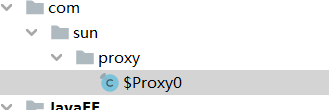JDK动态代理和cglib代理
文章目录
- 前言
- 1.JDK动态代理
-
- 1.1 定义一个接口
- 1.2 实现接口
- 1.3 自定义MyInvocationHandler去实现InvocationHandler接口
- 1.4 测试jdk代理
- 1.5 输出代理类
- 2.cglib代理
-
- 2.1 代理接口类
- 2.2 代理普通类
- 2.3 设置属性生成cglib代理类
前言
动态代理在平时的开发中用的也很多,统计接口调用耗时,日志功能,增强功能实现等。代理主要有两种 代理方式:
JDK动态代理特征
-
- 只能为接口创建代理对象
-
- 创建出来的代理都是java.lang.reflect.Proxy的子类
cglib代理
jdk动态代理只能代理接口类,cglib可以代理接口和普通类,通过子类来对被代理类实现增强扩展。
1.JDK动态代理
比如我们要统计某个方法的执行消耗的时间
1.1 定义一个接口
/**
* 定义接口
*/
public interface IMyService {
void method1();
}
1.2 实现接口
/**
* 实现接口
*/
public class MyService implements IMyService {
@Override
public void method1() {
System.out.println("method1 invokeed....");
}
}
1.3 自定义MyInvocationHandler去实现InvocationHandler接口
/**
* 自定义InvocationHandler
*/
public class MyInvocationHandler implements InvocationHandler {
private Object target;
//传入代理的目标类
public MyInvocationHandler(Object target) {
this.target = target;
}
@Override
public Object invoke(Object proxy, Method method, Object[] args) throws Throwable {
long startime = System.nanoTime();
Object result = method.invoke(this.target, args); //将请求转发给target去处理
long endTime = System.nanoTime();
System.out.println(method + ",耗时(纳秒):" + ( endTime- startime));
return result;
}
}
1.4 测试jdk代理
public class TestProxy {
public static void main(String[] args) {
//1.创建被代理类
IMyService service = new MyService();
//2.自定义InvocationHandler
MyInvocationHandler invocationHandler = new MyInvocationHandler(service);
//3.利用Proxy创建代理对象
Object proxyObject = Proxy.newProxyInstance(service.getClass().getClassLoader(), new Class[]{IMyService.class}, invocationHandler);
//4.执行代理方法
IMyService proxyService = (IMyService) proxyObject;
//5.执行方法
proxyService.method1();
}
}
1.5 输出代理类
///加属性
//设置属性生成代理类
System.getProperties().put("sun.misc.ProxyGenerator.saveGeneratedFiles","true");
public final class $Proxy0 extends Proxy implements IMyService {
private static Method m1;
private static Method m2;
private static Method m3;
private static Method m0;
public $Proxy0(InvocationHandler var1) throws {
super(var1);
}
public final boolean equals(Object var1) throws {
try {
return (Boolean)super.h.invoke(this, m1, new Object[]{var1});
} catch (RuntimeException | Error var3) {
throw var3;
} catch (Throwable var4) {
throw new UndeclaredThrowableException(var4);
}
}
public final String toString() throws {
try {
return (String)super.h.invoke(this, m2, (Object[])null);
} catch (RuntimeException | Error var2) {
throw var2;
} catch (Throwable var3) {
throw new UndeclaredThrowableException(var3);
}
}
public final void method1() throws {
try {
super.h.invoke(this, m3, (Object[])null);
} catch (RuntimeException | Error var2) {
throw var2;
} catch (Throwable var3) {
throw new UndeclaredThrowableException(var3);
}
}
public final int hashCode() throws {
try {
return (Integer)super.h.invoke(this, m0, (Object[])null);
} catch (RuntimeException | Error var2) {
throw var2;
} catch (Throwable var3) {
throw new UndeclaredThrowableException(var3);
}
}
static {
try {
m1 = Class.forName("java.lang.Object").getMethod("equals", Class.forName("java.lang.Object"));
m2 = Class.forName("java.lang.Object").getMethod("toString");
m3 = Class.forName("com.elite.javaee.service.IMyService").getMethod("method1");
m0 = Class.forName("java.lang.Object").getMethod("hashCode");
} catch (NoSuchMethodException var2) {
throw new NoSuchMethodError(var2.getMessage());
} catch (ClassNotFoundException var3) {
throw new NoClassDefFoundError(var3.getMessage());
}
}
}
可以看到生成代理类 ,集成了Proxy并实现了代理的接口,代理类的方法有4个,其他的都是默认的方法,m3是代理生成的。
2.cglib代理
jdk代理需要的缺点是只能代理接口类,而cglib不一样 ,可以代理普通的类,是通过增强扩展实现,相当于创建一个被代理类的子类,能够重写父类方法,也是符合设计原则中的里式替换原则。
2.1 代理接口类
public class TestCglibProxy {
public static void main(String[] args) {
//1.创建一个enhancer类
/**
* Generates dynamic subclasses to enable method interception.
* This class started as a substitute for the standard Dynamic Proxy support included with JDK 1.3,
* but one that allowed the proxies to extend a concrete base class,
* in addition to implementing interfaces. T
* he dynamically generated subclasses override the non-final methods of the superclass and have hooks which callback to user-defined interceptor implementations.
* The original and most general callback type is the MethodInterceptor, which in AOP terms enables "around advice"--that is, you can invoke custom code both before and after the invocation of the "super" method.
* In addition you can modify the arguments before calling the super method, or not call it at all.
* Although MethodInterceptor is generic enough to meet any interception need, it is often overkill.
* For simplicity and performance, additional specialized callback types, such as LazyLoader are also available.
* Often a single callback will be used per enhanced class, but you can control which callback is used on a per-method basis with a CallbackFilter.
* The most common uses of this class are embodied in the static helper methods.
* For advanced needs, such as customizing the ClassLoader to use, you should create a new instance of Enhancer.
* Other classes within CGLIB follow a similar pattern.
* All enhanced objects implement the Factory interface,
* unless setUseFactory is used to explicitly disable this feature.
* The Factory interface provides an API to change the callbacks of an existing object,
* as well as a faster and easier way to create new instances of the same type.
*/
Enhancer enhancer = new Enhancer();
//2.设置代理的类
enhancer.setInterfaces(new Class[]{IMyService.class});
//2.通过设置callback来代理拦截的方法
enhancer.setCallback(new MethodInterceptor() {
@Override
public Object intercept(Object o, Method method, Object[] objects, MethodProxy methodProxy) throws Throwable {
System.out.println("cglib代理的方法==》"+method.getName());
return null;
}
});
IMyService proxyService = (IMyService) enhancer.create();
proxyService.method1();
}
}
2.2 代理普通类
其他代码都一致
//设置代理的父类
enhancer.setSuperclass(Service.class);
Service service = (Service) enhancer.create();
service.method2();
2.3 设置属性生成cglib代理类
//设置属性生成代理类
System.setProperty(DebuggingClassWriter.DEBUG_LOCATION_PROPERTY, "D:\\devproject\\devcode\\code\\SSMCollection\\com\\sun\\proxy");


